Special Report
States With the Best and Worst Early Education

Published:
Last Updated:

The importance of socialization, proper nutrition, and education during early childhood is difficult to overstate. Multiple studies have linked enrollment in quality early childhood education programs with a greater chance for success, not only academically during school years, but also later in life — reducing the likelihood of poverty, unemployment, and criminality.
While the COVID-19 pandemic has reduced access to pre-K programs across the United States, school districts are beginning to reopen. Annual pre-K spending in the United States totals $6,329 per pupil on average, and an estimated 46.2% of 3- and 4-year-old children are enrolled in preschool. These, and other key measures of investment, accessibility, and quality vary considerably by state, however.
Using data from the National Institute of Early Childhood Education Research and the U.S. Census Bureau, 24/7 Wall St. created an index consisting of a state’s pre-K spending, enrollment rates, assistance for needy families, fourth grade reading and math proficiency, and certain quality standards, to rank states’ overall quality of early childhood education programs, from the worst to the best.
In many states, early childhood education programs specifically target at-risk children. These publicly funded pre-K programs prioritize enrollment for children facing challenging conditions outside of the classroom. While who is considered at risk may vary from state to state, children in foster care, children with disabilities, and children in low-income households are often included. Here is a look at how many children live in poverty in your state.
While most states offer some public pre-K option, many children, particularly those not considered to be at risk, are not prioritized for enrollment. In these cases, families will often enroll their child in a private preschool or seek other child care options. Parents who can afford to pay the tuition may also choose private preschool , even if a public option is available for their child. Nationwide, 40.6% of children in pre-K are in a private program, and 59.4% are in a public one. Here is a look at the best private high school in each state.
Click here to see states with the best and worst early education.
Click here to see the detailed methodology.

50. Idaho
> Share of 3-4 yr. olds enrolled in pre-K: 31.6% (2nd lowest)
> Annual state pre-K spending: $0 (the lowest)
> State pre-K spending per pre-K student: $0 (the lowest)
> 4th graders proficient in reading: 37.4% (12th highest); math: 43.0% (18th highest)
Based on a range of key measures, Idaho has the worst early childhood education of any state in the country. As of 2020, the state did not invest at all in public preschool, making it difficult for lower-income families in some parts of the state to put their 3- and 4-year-old children in school. Likely partially as a result, only 31.6% of 3- and 4-year-olds in the state are enrolled in pre-K, nearly the smallest share of any state.
Though it does not have a state-sponsored pre-K program, Idaho does use federal money granted through the Temporary Assistance for Needy Families program for early childhood education. Last year, Idaho used a TANF grant to conduct a needs assessment on early childhood education.
[in-text-ad]
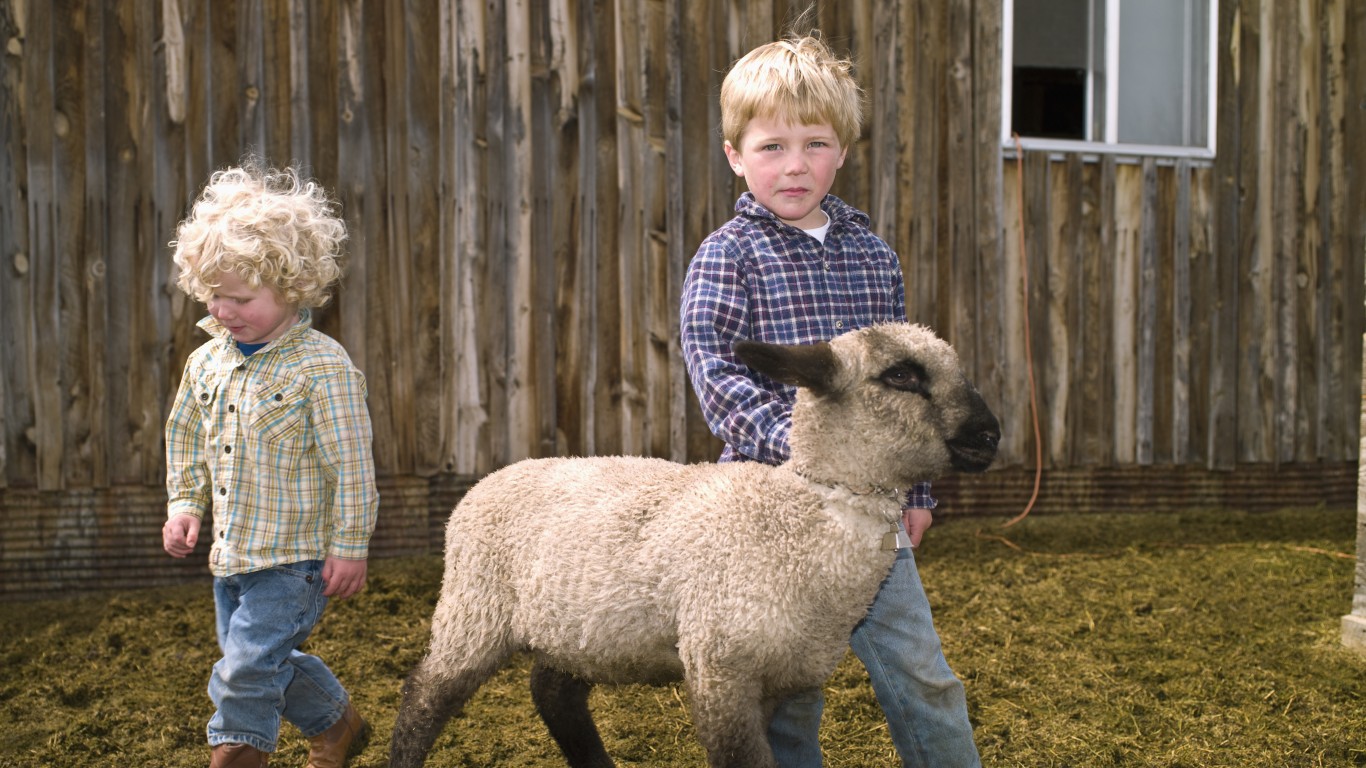
49. Montana
> Share of 3-4 yr. olds enrolled in pre-K: 36.8% (8th lowest)
> Annual state pre-K spending: $0 (the lowest)
> State pre-K spending per pre-K student: $0 (the lowest)
> 4th graders proficient in reading: 36.4% (16th highest); math: 42.6% (19th highest)
Like neighboring Idaho, South Dakota, and Wyoming, and several other states, Montana does not have a state-funded pre-K program. Though Montana had a preschool pilot program that ran for two years, the state legislature did not approve a $30 million expansion of the program in 2020.
Without a state-funded preschool program, pre-K enrollment in Montana is low. Just 36.8% of 3- and 4-year-old children in the state are in pre-K, one of the 10 smallest shares among states.
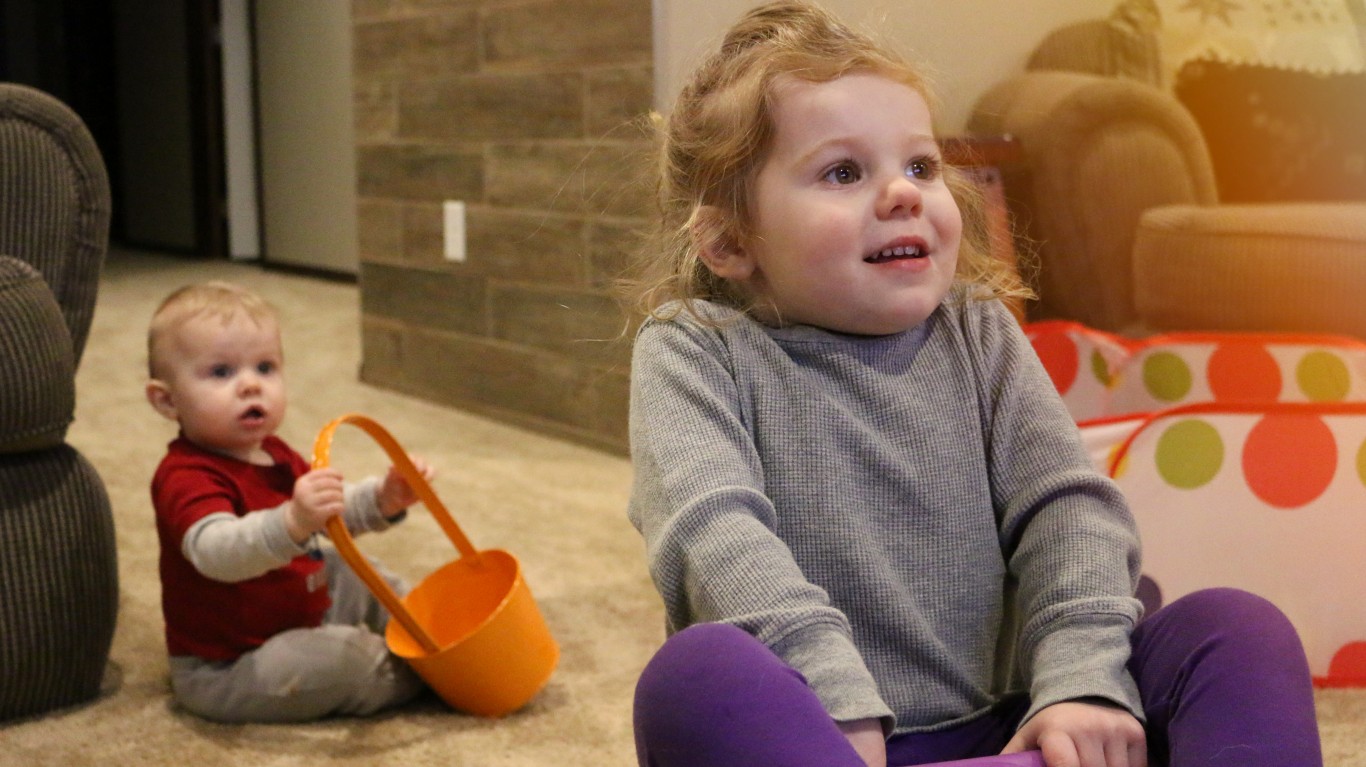
48. North Dakota
> Share of 3-4 yr. olds enrolled in pre-K: 31.8% (3rd lowest)
> Annual state pre-K spending: $650,659 (7th lowest)
> State pre-K spending per pre-K student: $527 (7th lowest)
> 4th graders proficient in reading: 34.3% (22nd lowest); math: 44.3% (15th highest)
Of the 44 states that fund early childhood education, North Dakota spends the least — both in absolute terms and per capita. The state spent just $650,659 on pre-K in 2020, or $527 per pre-K student, well below the $5,499 average spending per student among states nationwide.
Early childhood education is relatively new in North Dakota, as the state legislature first approved ECE grants in the 2017-2018 school year. However, unlike many other states, only 4-year-old children who qualify for free or reduced-price lunch are eligible for the state-sponsored pre-K. Likely partially as a result, only 31.8% of all 3- and 4-year-olds in the state are enrolled in pre-K, the third smallest share of any state.

47. South Dakota
> Share of 3-4 yr. olds enrolled in pre-K: 40.7% (14th lowest)
> Annual state pre-K spending: $0 (the lowest)
> State pre-K spending per pre-K student: $0 (the lowest)
> 4th graders proficient in reading: 36.0% (20th highest); math: 43.0% (17th highest)
South Dakota has no state-funded preschool program and ranks as one of the worst states for early childhood education. The absence of a statewide public preschool option makes it difficult for many families, particularly low-income families who cannot afford child care or a private preschool, to enroll their children in early childhood education. Indeed, only 40.7% of 3- and 4-year-olds in the state are in pre-K, one of the 15 smallest shares among states.
Still, many local school districts in the state fund their own early childhood education programs. Additionally, for the last decade, the South Dakota Bright Start Home Visiting Nurses Initiative has been providing Native American children in the state with services that focus on early childhood development. Native Americans account for nearly 9% of South Dakota’s population. Similarly, the Department of Social Services administers child care assistance payments to low-income families in the state. Though it is important to note that child care is not necessarily the same as early childhood education.
[in-text-ad-2]
46. Arizona
> Share of 3-4 yr. olds enrolled in pre-K: 38.5% (11th lowest)
> Annual state pre-K spending: $19.2 million (14th lowest)
> State pre-K spending per pre-K student: $3,686 (13th lowest)
> 4th graders proficient in reading: 31.4% (10th lowest); math: 37.3% (15th lowest)
According to NIEER, it costs a minimum of $10,455 a year per student to fund full-day, high-quality preschool in Arizona. However, due in part to half-day programs, Arizona spends just $3,686 per pre-K student annually, one of the larger funding gaps among states. The funding gap may explain why Arizona falls short in a number of quality standards. For example, the state does not require specialized teacher training for pre-K and has relatively large class sizes.
High quality early childhood can improve academic achievement for students in later years, and by some measures, academic outcomes are lagging in Arizona. Only 31.4% of fourth graders in the state are proficient in reading and 37.3% are proficient in math, the 10th and 15th smallest shares, respectively, among states.
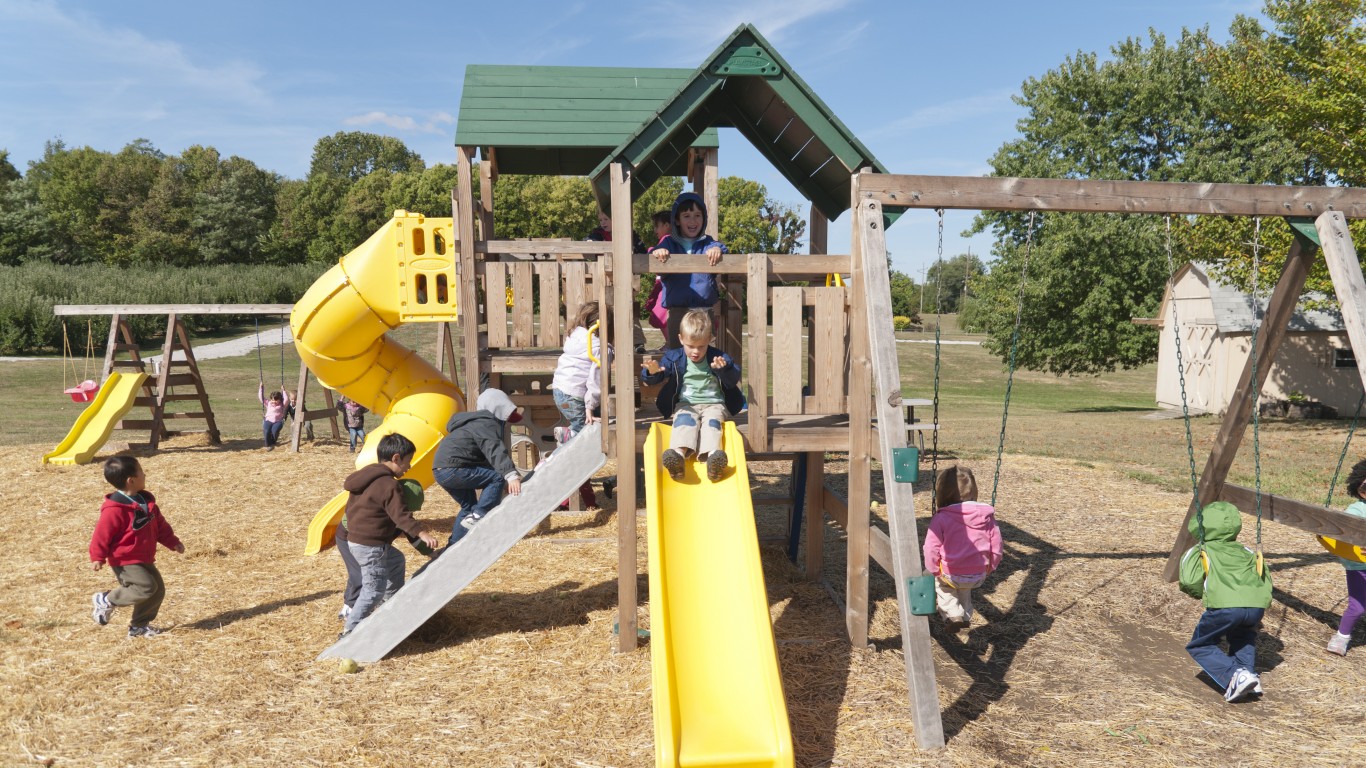
45. Indiana
> Share of 3-4 yr. olds enrolled in pre-K: 40.5% (13th lowest)
> Annual state pre-K spending: $0 (the lowest)
> State pre-K spending per pre-K student: $0 (the lowest)
> 4th graders proficient in reading: 37.0% (14th highest); math: 47.1% (8th highest)
One of only six states without a state-funded pre-K program, Indiana has one of the worst early childhood education programs in the United States. While there is no universal public pre-K option in Indiana, the state provides grants that fund education services for qualifying low-income 4-year-old children. The program, known as On My Way Pre-K, supported over 3,500 children in the 2019-2010 school year with $6.8 million in state funding.
Indiana’s relatively limited ECE offerings means that a larger than average share of young children are not in school. Only 40.5% of 3- and 4-year-olds in the state are in a pre-K program, a smaller share than in all but a dozen other states.
[in-text-ad]
44. South Carolina
> Share of 3-4 yr. olds enrolled in pre-K: 37.8% (9th lowest)
> Annual state pre-K spending: $86.0 million (25th highest)
> State pre-K spending per pre-K student: $3,216 (12th lowest)
> 4th graders proficient in reading: 31.8% (13th lowest); math: 36.3% (11th lowest)
South Carolina ranks among the 10 worst states for early childhood education largely because of a lack of investment. The Child Care and Development Fund is a federal and state partnership that provides low-income families with child care assistance and funds aimed at improving early childhood education standards. Just 5.1% of children in South Carolina living below the poverty line receive CCDF funds, the smallest share of any state and less than half the 11.6% national share. Meanwhile, South Carolina’s 19.7% child poverty rate is well above the 16.8% national rate.
According to NIEER, it costs a minimum of $11,349 a year per student to fund full-day, high-quality preschool in South Carolina. However, South Carolina state spending totals just $3,216 per pre-K student annually, one of the largest funding gaps among states.

43. Texas
> Share of 3-4 yr. olds enrolled in pre-K: 40.3% (12th lowest)
> Annual state pre-K spending: $842.2 million (2nd highest)
> State pre-K spending per pre-K student: $3,693 (15th lowest)
> 4th graders proficient in reading: 30.3% (6th lowest); math: 43.7% (16th highest)
Only a handful of states have an early childhood education program that ranks lower than Texas’s. According to NIEER, it costs a minimum of $12,168 a year per student to fund full-day, high-quality preschool in Texas. However, due in part to half-day programs, Texas spends just $3,693 per pre-K student annually, one of the larger funding gaps among states. Likely as a result, Texas falls short in a number of quality standards. For example, the state does not have quality improvement or class size standards in place.
COVID-19 presented a massive disruption in American education, and Texas did not take measures many other states did to assist those 3- and 4-year-olds and their families. During the COVID-19-related school closures, Texas did not provide meals or learning materials like books or toys to preschool families.

42. Wyoming
> Share of 3-4 yr. olds enrolled in pre-K: 31.9% (4th lowest)
> Annual state pre-K spending: $0 (the lowest)
> State pre-K spending per pre-K student: $0 (the lowest)
> 4th graders proficient in reading: 40.6% (3rd highest); math: 47.8% (5th highest)
Like several other states it shares a border with, Wyoming does not offer a publicly funded pre-K program. As is often the case in states without a universal public preschool program, pre-K enrollment in Wyoming is low. Only 31.9% of 3- and 4-year-old children in the state are in pre-K, the fourth smallest share among states.
Without a state program, local municipalities do offer some pre-K funding in Wyoming. Many school districts in the state allocate some of their Title I for early childhood education, and in 2020, the Wyoming Department of Education spent $3 million across eight preschools that serve low-income populations.
[in-text-ad-2]

41. Alaska
> Share of 3-4 yr. olds enrolled in pre-K: 47.3% (22nd highest)
> Annual state pre-K spending: $7.3 million (12th lowest)
> State pre-K spending per pre-K student: $5,212 (20th lowest)
> 4th graders proficient in reading: 25.1% (2nd lowest); math: 33.2% (5th lowest)
Alaska rounds out the list of the 10 states with the worst early childhood education programs. According to NIEER, it costs a minimum of $15,534 a year per student to fund full-day, high-quality preschool in Alaska. However, due in part to half-day programs, Alaska spends just $5,212 per pre-K student annually, one of the larger funding gaps among states. Alaska falls short in a number of quality standards. For example, the state does not require specialized teacher training for pre-K, has relatively large class sizes, and does not have quality improvement standards.
High quality early childhood education can improve student achievement in later years, and in many ways, students in Alaska are trailing their peers in much of the rest of the nation. Only 25.1% of fourth graders in the state are proficient in reading, and 33.2% in math, the second and fifth smallest shares, respectively, among states.

40. Wisconsin
> Share of 3-4 yr. olds enrolled in pre-K: 35.4% (7th lowest)
> Annual state pre-K spending: $179.0 million (11th highest)
> State pre-K spending per pre-K student: $6,200 (25th lowest)
> 4th graders proficient in reading: 35.5% (21st highest); math: 44.8% (13th highest)
Wisconsin offers universal public pre-K for 4-year-old children, but not 3-year olds. Partially as a result, 72% of 4-year-olds in Wisconsin are in a state-funded pre-K program, but only 1% of 3-year-olds are. Overall, just 35.4% of 3- and 4-year-olds in the state are enrolled in a pre-K program, a smaller share than in all but half a dozen other states.
Wisconsin ranks lower than most other states in early childhood education quality partially because it does not meet several important quality benchmarks. For example, the state does not have annual staff development requirements, and without statewide standards, class sizes and student-to-teacher ratios are determined locally.
[in-text-ad]
39. Kansas
> Share of 3-4 yr. olds enrolled in pre-K: 48.8% (13th highest)
> Annual state pre-K spending: $26.6 million (18th lowest)
> State pre-K spending per pre-K student: $2,085 (8th lowest)
> 4th graders proficient in reading: 33.8% (19th lowest); math: 40.3% (25th highest)
Kansas invests far less in early childhood education than most states. The state spent $26.6 million on pre-K in 2020, or $2,085 per student — among the 10 smallest state per child pre-K budgets. According to NIEER, it costs a minimum of $10,757 a year per student to fund full-day, high-quality preschool in Kansas. Despite the relatively low investment, pre-K programs enroll 48.8% of 3- and 4-year-olds in the state, a larger share than in most of the country.
Public preschool in Kansas is offered through two programs that fall under the purview of the state’s Department of Education. The first, known as the Preschool-Aged At-Risk program, was established in 1998 and now enrolls nearly 8,300 children across 231 school districts. The second is the Kansas Preschool Pilot program, which enrolls 4,500 children across 110 school districts.

38. Louisiana
> Share of 3-4 yr. olds enrolled in pre-K: 48.6% (15th highest)
> Annual state pre-K spending: $92.8 million (23rd highest)
> State pre-K spending per pre-K student: $4,623 (18th lowest)
> 4th graders proficient in reading: 25.7% (3rd lowest); math: 28.8% (3rd lowest)
Louisiana spent $92.8 million on pre-K education through its three state-funded ECE programs in 2020 — the largest of which is the LA 4 program that serves 4-year-old children in public schools, charter schools, and tribal schools. On a per-pupil basis, Louisiana spends just $4,539 per pre-K student annually, well below the estimated $10,747 minimum necessary for a high-quality, full-day pre-K program.
High quality early childhood education can improve student achievement in later years, and in many ways, students in Louisiana are trailing their peers in much of the nation. Only 25.7% of fourth graders in the state are proficient in reading and only 28.8% are proficient in math, each the third smallest share among states.
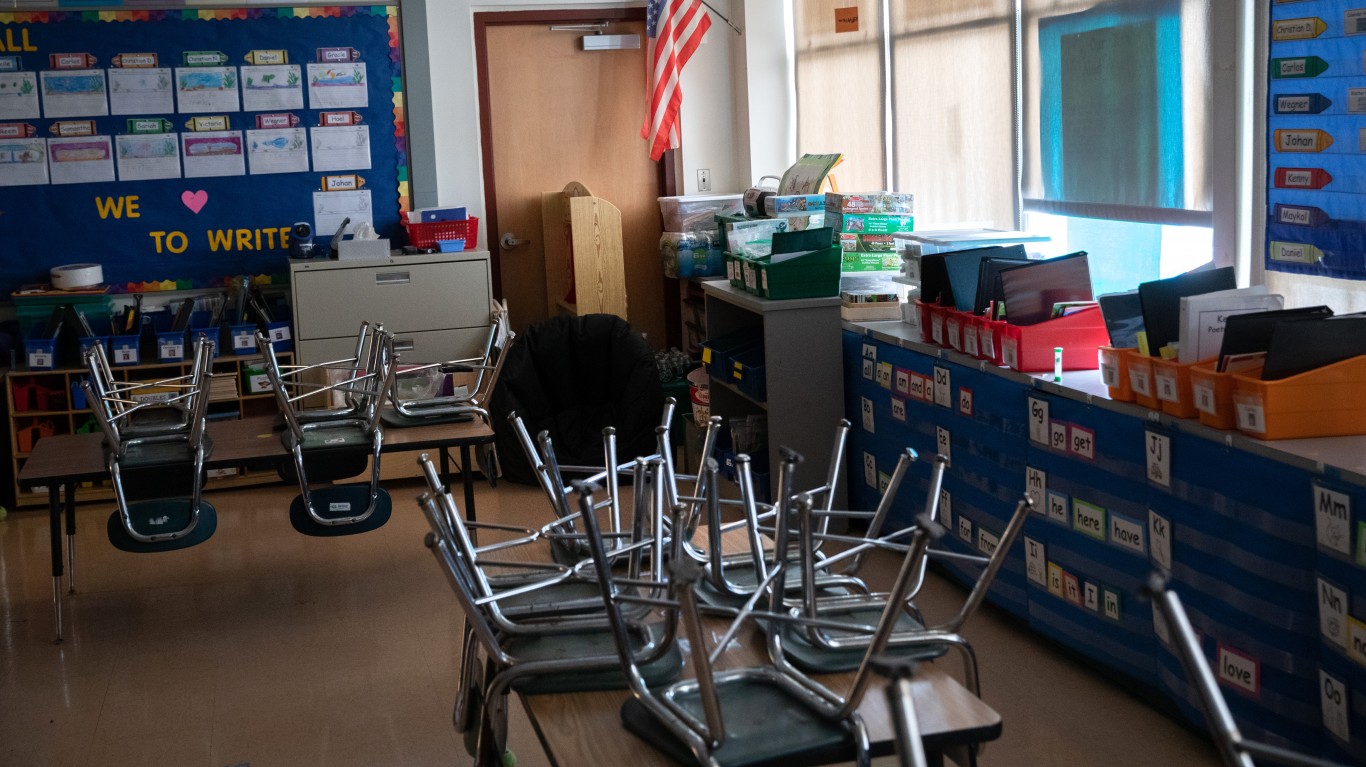
37. Nevada
> Share of 3-4 yr. olds enrolled in pre-K: 34.7% (5th lowest)
> Annual state pre-K spending: $19.7 million (15th lowest)
> State pre-K spending per pre-K student: $8,476 (14th highest)
> 4th graders proficient in reading: 30.9% (8th lowest); math: 34.3% (8th lowest)
Nevada more than doubled its spending on preschool programs in the 2019-2020 school year compared to the previous year. Partially as a result, per pupil spending in the state totals $6,428 — among the 15 highest in the country. Despite the increased investment, pre-K enrollment remains low in Nevada, as it is one of only five states in which fewer than 35% of 3- and 4-year-olds are enrolled in pre-K.
Low preschool enrollment in the state may partially explain poor academic performance for many students in Nevada in later years. Just 30.9% of fourth graders in the state are proficient in reading and 34.3% are proficient in math, each the eighth smallest share among states.
[in-text-ad-2]
36. Utah
> Share of 3-4 yr. olds enrolled in pre-K: 42.5% (17th lowest)
> Annual state pre-K spending: $6.9 million (11th lowest)
> State pre-K spending per pre-K student: $3,074 (10th lowest)
> 4th graders proficient in reading: 40.0% (5th highest); math: 46.3% (9th highest)
During Utah’s 2019 legislative session, lawmakers passed the School Readiness Amendments, which appropriated state funds to pay for preschool programs for the first time in the 2019-2020 school year. One of the newest states to join the ranks of those offering publicly funded pre-K, Utah has yet to meet several quality benchmarks. For example, the state does not require pre-K teachers to have a bachelor’s degree or specialized pre-K training. Additionally, though some school districts have structured classroom observations in order to improve programs, these initiatives are not mandated statewide.
Pre-K enrollment is slightly lower than average in Utah. Just 42.5% of 3- and 4-year-old children in the state are in a pre-K program, a smaller share than in most states.

35. Florida
> Share of 3-4 yr. olds enrolled in pre-K: 50.6% (12th highest)
> Annual state pre-K spending: $400.3 million (6th highest)
> State pre-K spending per pre-K student: $2,401 (9th lowest)
> 4th graders proficient in reading: 37.7% (11th highest); math: 47.5% (6th highest)
Early childhood education ranks worse in Florida than it does in most other states, partially due to inadequate funding. According to NIEER, it costs a minimum of $11,186 a year per student to fund full-day, high-quality preschool in Florida. However, due in part to half-day programs, Florida spends just $2,401 per pre-K student annually, one of the largest funding gaps among states.
Florida has a Voluntary Prekindergarten Education Program that provides pre-K access for all 4-year-olds in the state. As a result, 72% of all 4-year old children in Florida are enrolled in a state funded pre-K program. However, there are no state-funded programs for 3-year-olds.
[in-text-ad]

34. California
> Share of 3-4 yr. olds enrolled in pre-K: 47.1% (23rd highest)
> Annual state pre-K spending: $1.9 billion (the highest)
> State pre-K spending per pre-K student: $8,037 (17th highest)
> 4th graders proficient in reading: 32.1% (14th lowest); math: 33.6% (7th lowest)
With a $1.9 billion budget, California is the only state where pre-K spending exceeded the $1 billion mark in 2020. Even adjusting for population, the state’s per pupil spending of $8,030 is higher than in all but half a dozen other states. Despite the heavy investment, California fails to meet several important quality benchmarks, according to NIEER. For example, pre-K teachers in California are not always required to have a bachelor’s degree, and there is no limit to class sizes for public pre-K classrooms in the state.
Student achievement and outcomes in later years can improve, on average, with high quality ECE. Only 32.1% of fourth graders in the state are proficient in reading, and 33.6% are proficient in math, the 14th and seventh smallest shares, respectively, among states.
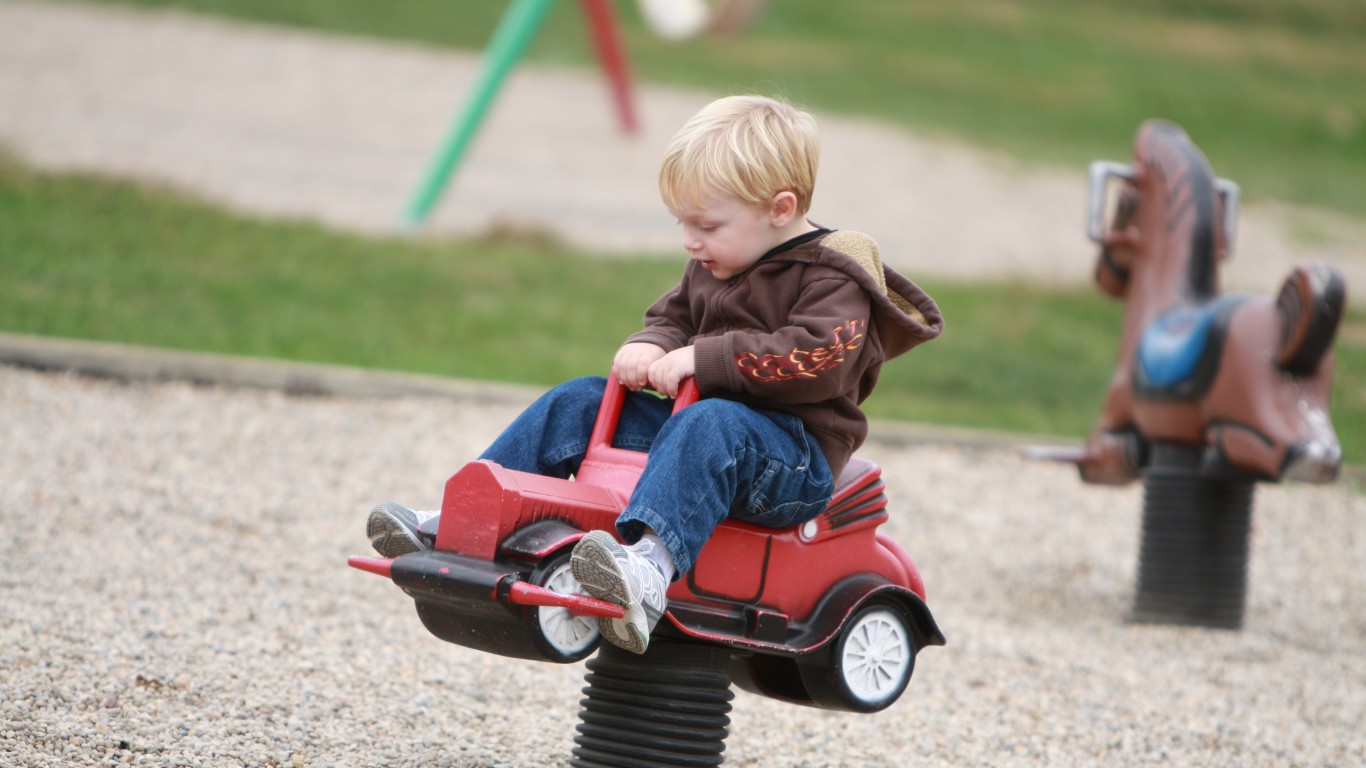
33. Ohio
> Share of 3-4 yr. olds enrolled in pre-K: 45.9% (25th highest)
> Annual state pre-K spending: $71.5 million (23rd lowest)
> State pre-K spending per pre-K student: $4,000 (17th lowest)
> 4th graders proficient in reading: 36.1% (17th highest); math: 41.1% (23rd highest)
The quality of early childhood education in Ohio is lower than in most other states. Pre-K spending in the state per pupil totals $4,000 — lower than in most of the country. Greater investment would likely help the state meet some important quality benchmarks. Currently, pre-K teachers in Ohio are not required to specialize in pre-K education. Additionally, there are no standing limits on pre-K class sizes or student-to-teacher ratios.
Currently, 45.9% of 3- and 4-year-olds in Ohio are enrolled in pre-K, close to the median among all states.

32. Missouri
> Share of 3-4 yr. olds enrolled in pre-K: 44.5% (22nd lowest)
> Annual state pre-K spending: $22.1 million (16th lowest)
> State pre-K spending per pre-K student: $3,208 (11th lowest)
> 4th graders proficient in reading: 34.2% (20th lowest); math: 39.3% (22nd lowest)
Pre-K spending in Missouri totaled $3,208 per student in 2020, less than in all but 10 other states. Enrollment is also lower than in the slight majority of states, at 44.5% of 3- and 4-year-old children.
The Missouri Preschool Program, which was launched in 1998, meets all key quality benchmarks laid out by NIEER. However, the program enrolls fewer than 500 3- and 4- year-olds. Meanwhile, more than 6,400 students are enrolled in programs funded by the state’s Pre-K Foundation Formula program, which only meets about half of all quality standard benchmarks, as it does not have class size limits and does not have classroom observation for data collection to be used for improvements.
[in-text-ad-2]

31. Georgia
> Share of 3-4 yr. olds enrolled in pre-K: 48.1% (19th highest)
> Annual state pre-K spending: $377.0 million (7th highest)
> State pre-K spending per pre-K student: $4,694 (19th lowest)
> 4th graders proficient in reading: 32.2% (15th lowest); math: 36.5% (12th lowest)
Georgia ranks among the 20 worst states for early childhood education largely because of a lack of investment. The Child Care and Development Fund is a federal and state partnership that provides low-income families with child care assistance and is aimed at improving early childhood education standards. Just 5.5% of children in Georgia living below the poverty line receive CCDF funds, the second smallest share of any state and less than half the 11.6% national share. Meanwhile, Georgia’s 18.7% child poverty rate is well above the 16.8% national rate.
Both pre-K enrollment and pre-K investment in Georgia rank towards the median of all states. An estimated 48.1% of 3- and 4-year-olds in the state are in a pre-K program, and per student pre-K spending in Georgia was $4,694 in 2020, the 19th highest and 19th lowest among states, respectively.
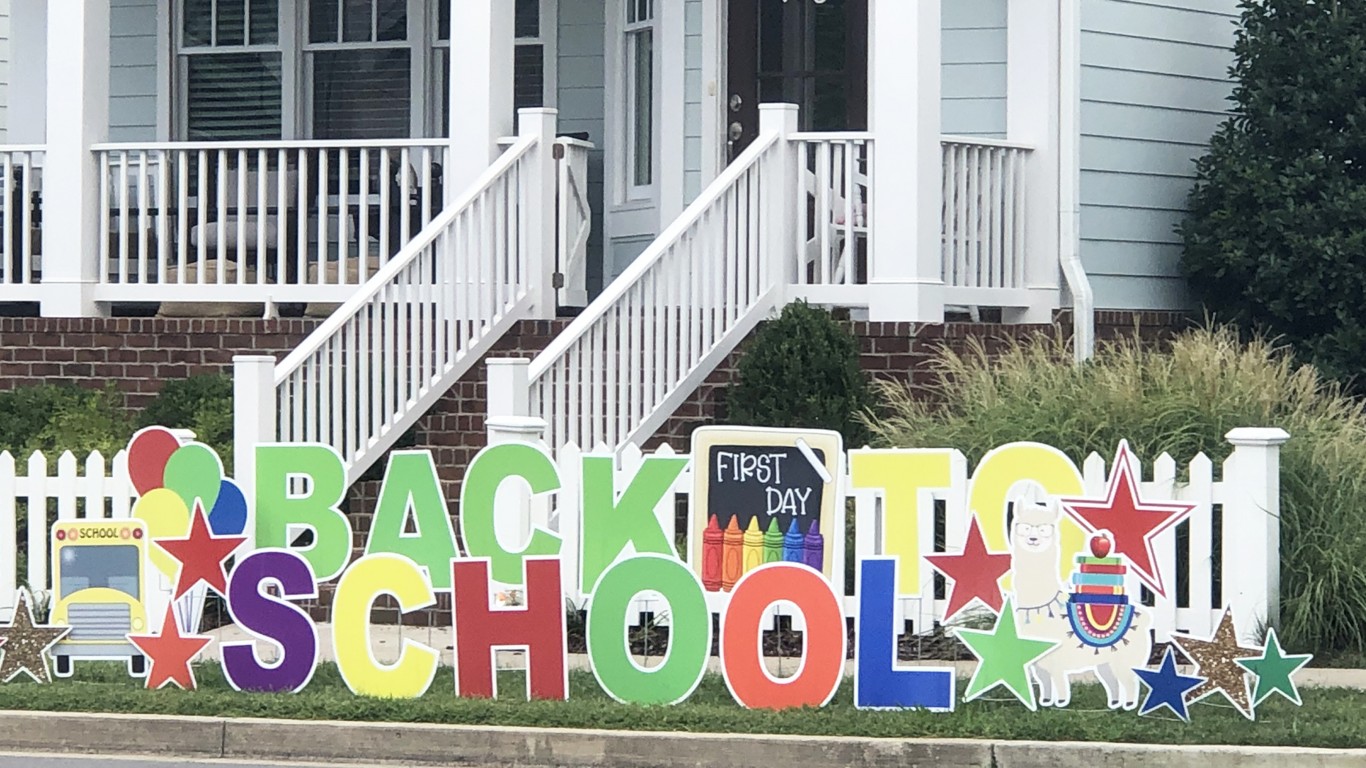
30. Tennessee
> Share of 3-4 yr. olds enrolled in pre-K: 38.1% (10th lowest)
> Annual state pre-K spending: $82.4 million (25th lowest)
> State pre-K spending per pre-K student: $5,734 (23rd lowest)
> 4th graders proficient in reading: 34.6% (24th lowest); math: 39.9% (24th lowest)
According to NIEER, it costs a minimum of $10,750 a year per student to fund full-day, high-quality preschool in Tennessee. However, Tennessee spends just $5,734 per pre-K student annually. Still, even with a considerable funding gap, the state meets most benchmarks of quality set by NIEER.
Tennessee’s Voluntary Pre-K operates in 138 of the 142 school districts in the state. Launched in 2005, the program prioritizes serving low-income and homeless children. Only 38.1% of 3- and 4-year-olds in the state are in a pre-K program, state-funded or otherwise, the 10th smallest share of any state.
[in-text-ad]

29. Arkansas
> Share of 3-4 yr. olds enrolled in pre-K: 46.1% (24th highest)
> Annual state pre-K spending: $114.0 million (17th highest)
> State pre-K spending per pre-K student: $9,026 (9th highest)
> 4th graders proficient in reading: 31.2% (9th lowest); math: 33.2% (6th lowest)
Arkansas ranks among the bottom half of states for early childhood education largely because of a lack of investment. The Child Care and Development Fund is a federal and state partnership that provides low-income families with child care assistance and is aimed at improving early childhood education standards. Just 5.5% of children in Arkansas living below the poverty line receive CCDF funds, nearly the smallest share of any state and less than half the 11.6% national share. Meanwhile, Arkansas’ 22.1% child poverty rate is well above the comparable 16.8% national rate and higher than all but four other states.
The state’s schools, including those involved in early childhood education, appear to be lagging behind much of the country in terms of teaching students core concepts. Only 31.2% of fourth graders in the state are proficient in reading, and 33.2% are proficient in math, each among the 10 lowest shares of any state.
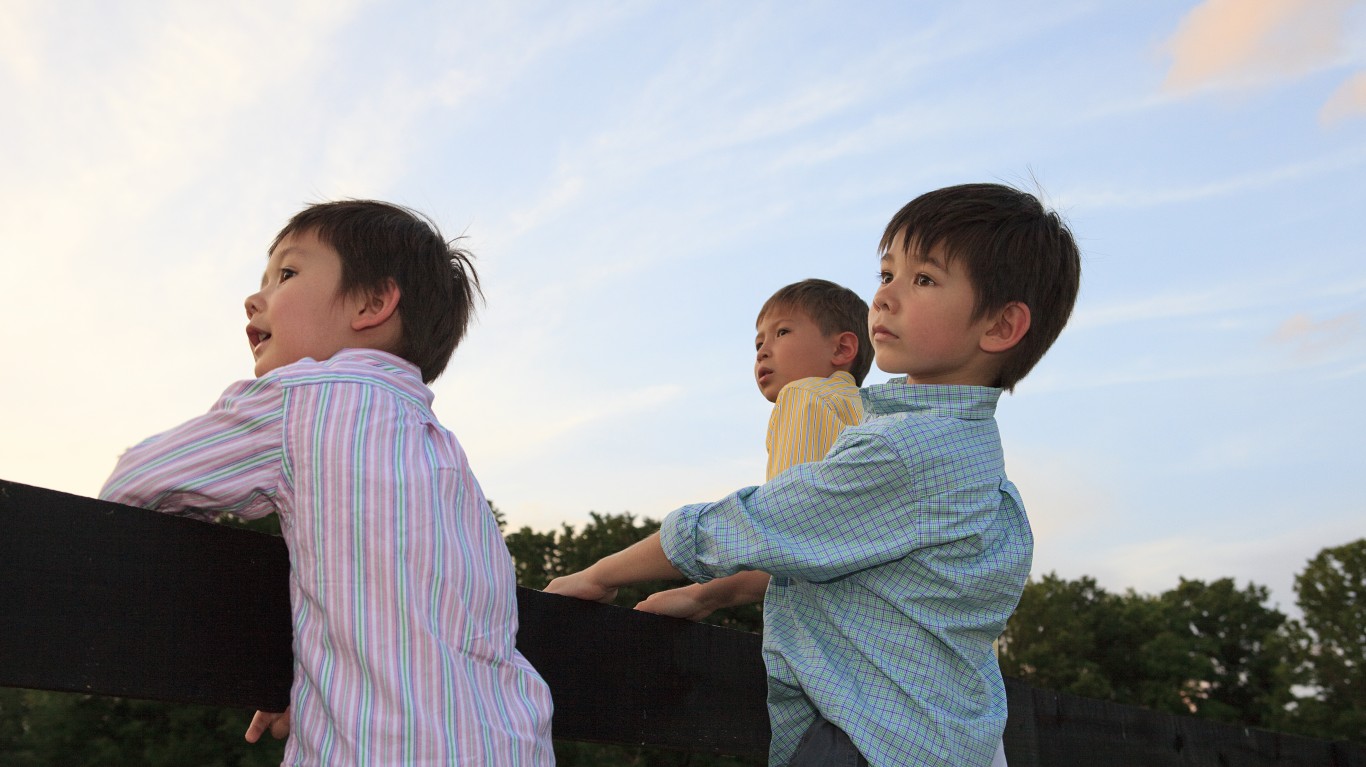
28. Kentucky
> Share of 3-4 yr. olds enrolled in pre-K: 35.2% (6th lowest)
> Annual state pre-K spending: $105.1 million (19th highest)
> State pre-K spending per pre-K student: $8,151 (16th highest)
> 4th graders proficient in reading: 35.1% (25th lowest); math: 39.9% (25th lowest)
Kentucky’s early childhood education system ranks close to the middle of all states. Pre-K spending in the state totaled $105.1 million in 2020, or $8,151 per student, a higher per capita spending figure than in all but 15 other states. However, enrollment in pre-K programs is lower than average in Kentucky. Just 35.2% of 3- and 4-year-olds are in a pre-K program, a smaller share than in all but five other states.
The Kentucky Preschool Program, the state’s publicly funded early childhood education program, is available to 4-year old children in low-income households and 3- and 4-year-olds with disabilities. Other children may also enroll depending on the availability of space, although they may be charged tuition.
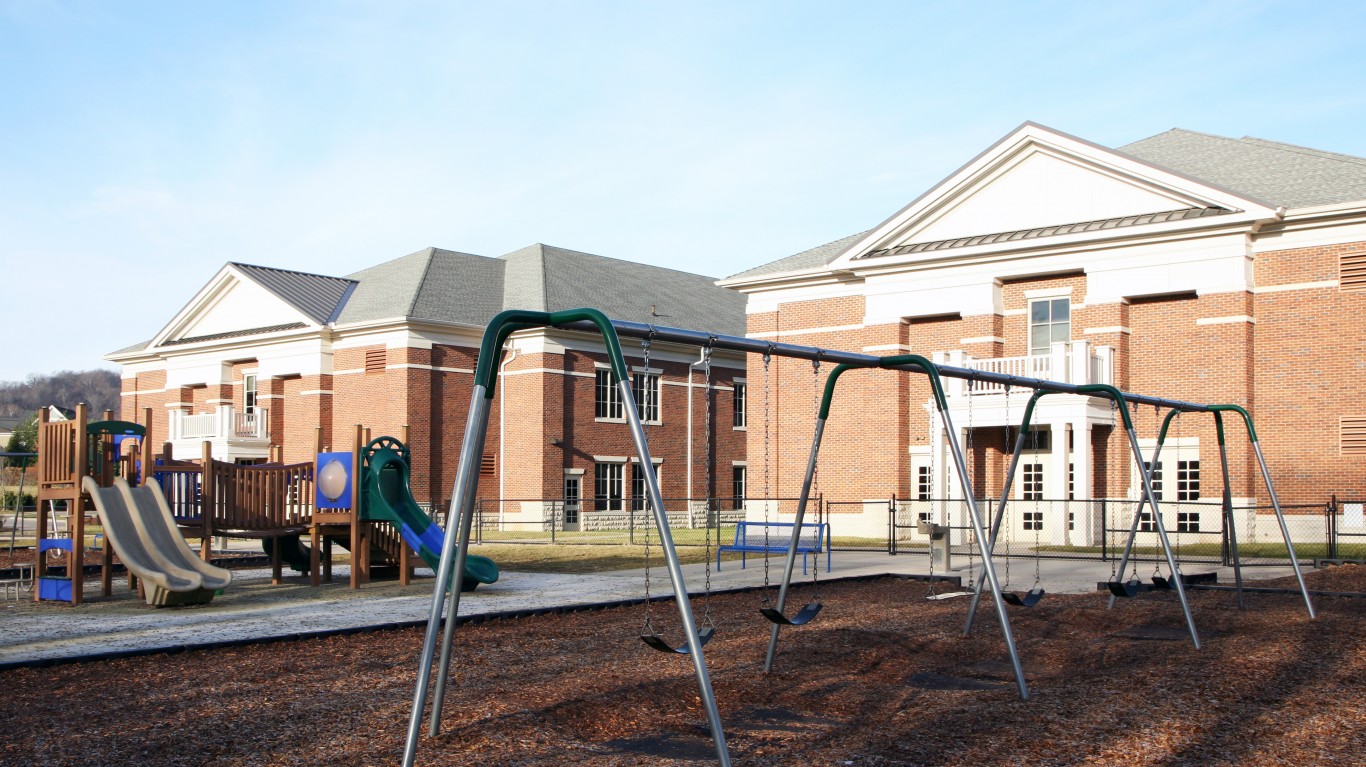
27. West Virginia
> Share of 3-4 yr. olds enrolled in pre-K: 31.0% (the lowest)
> Annual state pre-K spending: $96.8 million (20th highest)
> State pre-K spending per pre-K student: $10,313 (3rd highest)
> 4th graders proficient in reading: 30.3% (7th lowest); math: 29.6% (4th lowest)
West Virginia is one of only a handful of states that meets the estimated spending threshold necessary for high-quality, full-day pre-K. Pre-K spending in West Virginia totaled $10,313 per student in 2020, higher than the minimum standard in the state of $10,209, according to NIEER. However, only 31.0% of 3- and 4-year-olds are enrolled in preschool education, lower than in every other state. The low enrollment is partially because universal pre-K is only available to 4-year-old children but not all 3-year-olds.
West Virginia’s education system, including its early childhood programs, do not appear to be adequately preparing students for absorbing essential materials. Only 30.3% of fourth graders in the state are proficient in reading, and 29.6% are proficient in math, the seventh and fourth smallest shares among states, respectively.
[in-text-ad-2]

26. Colorado
> Share of 3-4 yr. olds enrolled in pre-K: 50.6% (11th highest)
> Annual state pre-K spending: $70.5 million (22nd lowest)
> State pre-K spending per pre-K student: $5,434 (21st lowest)
> 4th graders proficient in reading: 39.7% (7th highest); math: 44.5% (14th highest)
Colorado made its state preschool program permanent in 1992, offering eligibility to a wide range of children who meet certain risk factors, including being a dual language learner or being in foster care. Preschools in Colorado have relatively high enrollment rates. Just over half of all 3- and 4-year-old children in the state are in a pre-K program, one of the larger shares among states. Still, Colorado ranks close to the median among all states in terms of pre-K quality.
The state’s preschools fall short in several quality benchmarks established by NIEER. For example, teachers are not required to have a bachelor’s degree. Pre-K spending in the state totaled just $5,434 per student in 2020, well below the $11,469 estimated minimum needed for a full-day, high-quality program according to NIEER.

25. New Mexico
> Share of 3-4 yr. olds enrolled in pre-K: 42.1% (15th lowest)
> Annual state pre-K spending: $88.5 million (24th highest)
> State pre-K spending per pre-K student: $7,334 (19th highest)
> 4th graders proficient in reading: 23.7% (the lowest); math: 28.7% (2nd lowest)
New Mexico invests more in its preschools on a per-child basis than most states. Pre-K spending totaled $7,334 per student in 2020, ranking in the top 20 among states. Still, the state ranks towards the middle of all states for its early childhood education system partially due to relatively low enrollment. Only 42.1% of 3- and 4-year-olds in the state are in a pre-K program, the 15th smallest share among states.
The low enrollment may partially explain the poor academic performance for many students in New Mexico in later years. Just 23.7% of fourth graders in the state are proficient in reading, and 28.7% are proficient in math, the lowest and second lowest shares among states, respectively.
[in-text-ad]
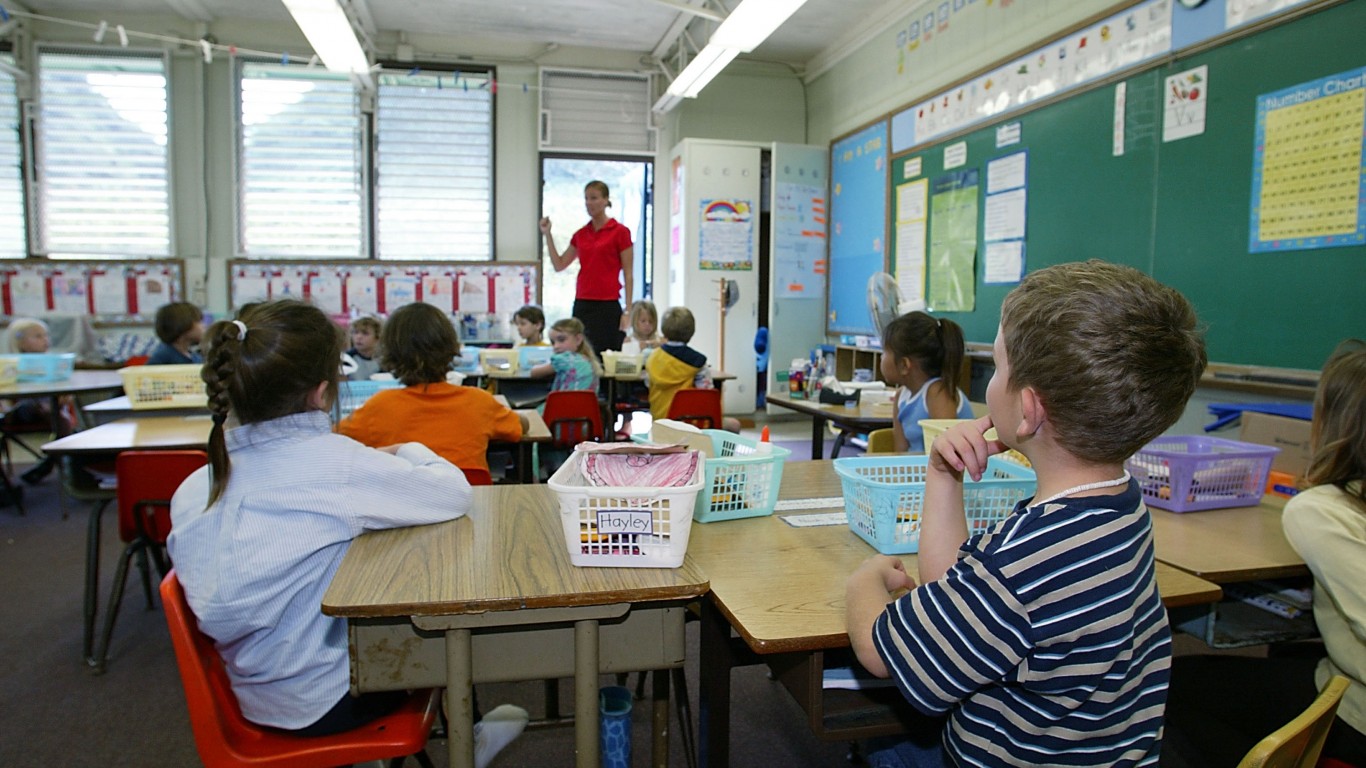
24. Virginia
> Share of 3-4 yr. olds enrolled in pre-K: 48.3% (17th highest)
> Annual state pre-K spending: $75.7 million (24th lowest)
> State pre-K spending per pre-K student: $7,239 (21st highest)
> 4th graders proficient in reading: 38.3% (8th highest); math: 47.9% (4th highest)
By several measures, preschools in Virginia rank close to the median across all states. For example, 48.3% of 3- and 4-year-olds in the state are enrolled in a pre-K program, a larger share than in all but 16 other states. Additionally, pre-K spending in the state totaled $7,239 per student in 2020, more than in all but 20 other states.
The Virginia Preschool Initiative was started in 1995 to serve at-risk 4-year-old children. The program is funded by lottery revenue in addition to local revenue sources. Though the publicly funded program serves nearly all of its target demographic, 54.8% of the 3- and 4-year-olds who are enrolled in school in Virginia are enrolled in private preschools, the second largest share among states.
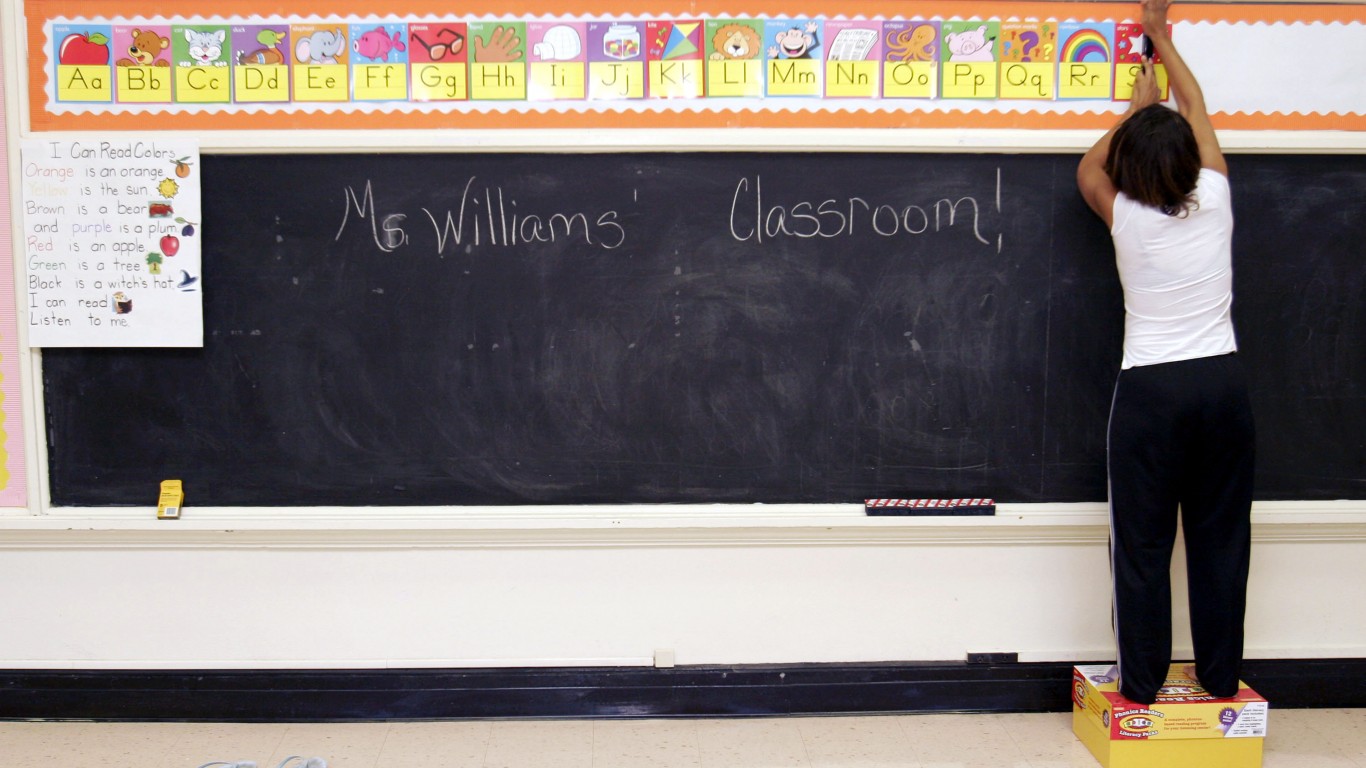
23. New Hampshire
> Share of 3-4 yr. olds enrolled in pre-K: 58.0% (4th highest)
> Annual state pre-K spending: $0 (the lowest)
> State pre-K spending per pre-K student: $0 (the lowest)
> 4th graders proficient in reading: 38.2% (9th highest); math: 45.8% (10th highest)
The preschool system in New Hampshire ranks below every other state in the New England region but still higher than most other states. New Hampshire is one of only six states without a state-run pre-K program. However, the state does provide financial support for locally run ECE programs and has guidelines that address education and development issues for children up through age 5.
Despite the lack of a state-run pre-K program, 58% of 3- and 4-year-olds in New Hampshire are enrolled in pre-K. About half of them are in private schools, and the other half are in public schools. Reading and math scores on standardized tests in the state also compare well to much of the country for young students. A reported 38.2% of fourth graders in the state are proficient in reading, and 45.8% are proficient in math, each among the 10 largest shares among states.
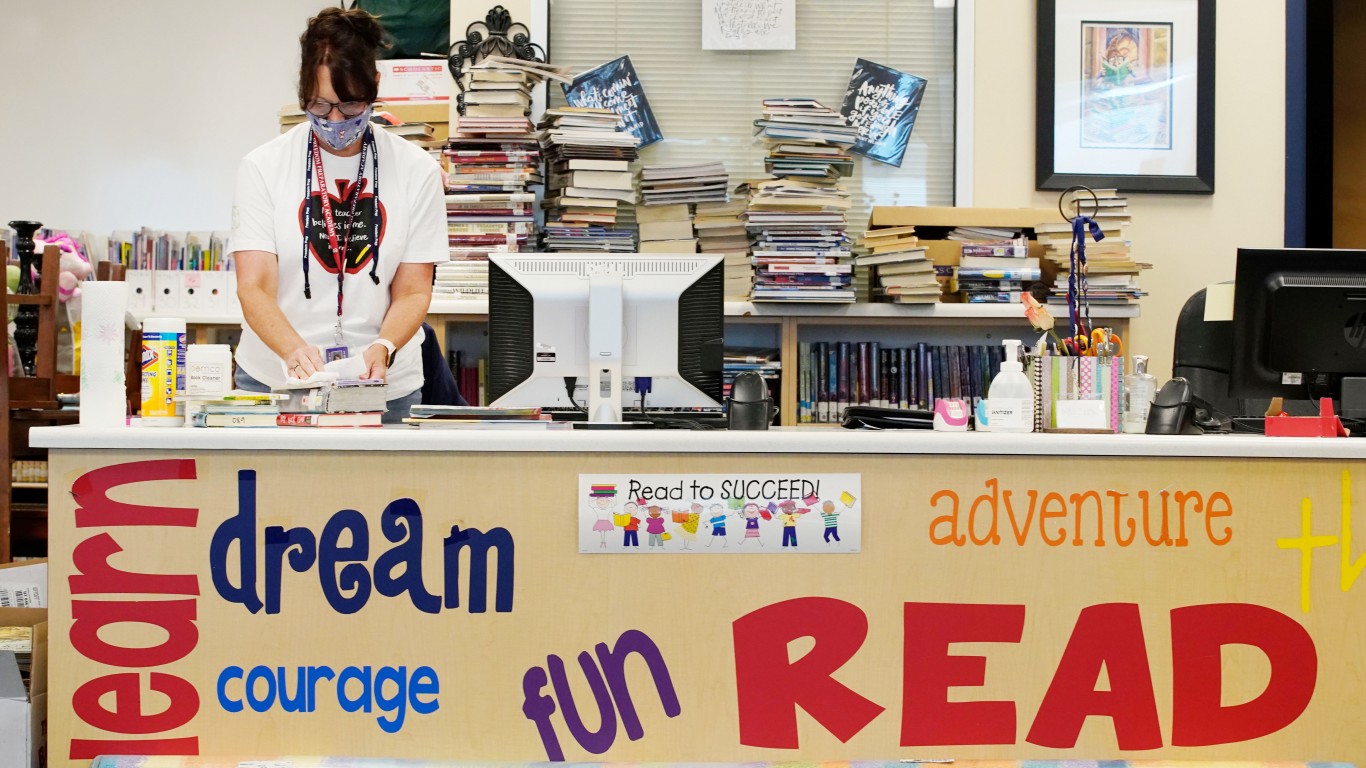
22. Michigan
> Share of 3-4 yr. olds enrolled in pre-K: 44.6% (23rd lowest)
> Annual state pre-K spending: $249.6 million (9th highest)
> State pre-K spending per pre-K student: $6,680 (25th highest)
> 4th graders proficient in reading: 31.6% (12th lowest); math: 35.6% (10th lowest)
Michigan’s state-run pre-K program provides education to at-risk 4-year-old children while offering relatively few options for 3-year-olds in the state. Partially as a result, while 33.3% of 4-year-olds in Michigan are enrolled in a state-run pre-K program, only 3.6% of 3-year-olds are. An estimated 44.6% of all 3- and 4-year-olds in the state are enrolled in some pre-K program, public or private, a smaller share than in a slight majority of states.
At $6,680, total per pupil spending on pre-K in Michigan is close to the median among all states. However, funding falls well short of the $12,062 minimum threshold necessary to prove high-quality, full-day pre-K, as estimated by NIEER.
[in-text-ad-2]

21. Oregon
> Share of 3-4 yr. olds enrolled in pre-K: 42.6% (18th lowest)
> Annual state pre-K spending: $96.3 million (21st highest)
> State pre-K spending per pre-K student: $10,164 (4th highest)
> 4th graders proficient in reading: 33.8% (17th lowest); math: 37.2% (14th lowest)
Oregon has some of the highest pre-K spending of any state in the country. Pre-K spending in the state totaled $10,164 per pupil in 2020, more than the student adjusted spending in all but three other states. There are two state-run pre-K programs in the state: the Oregon Pre-Kindergarten program, which provides child development services for 3- and 4-year-olds in low-income households, and the Preschool Promise program, which is available to children in households earning double the poverty level or less.
Despite a relatively robust state-funded system, only 42.6% of 3- and 4-year-old children in the state are in a pre-K program, a smaller share than in most other states.
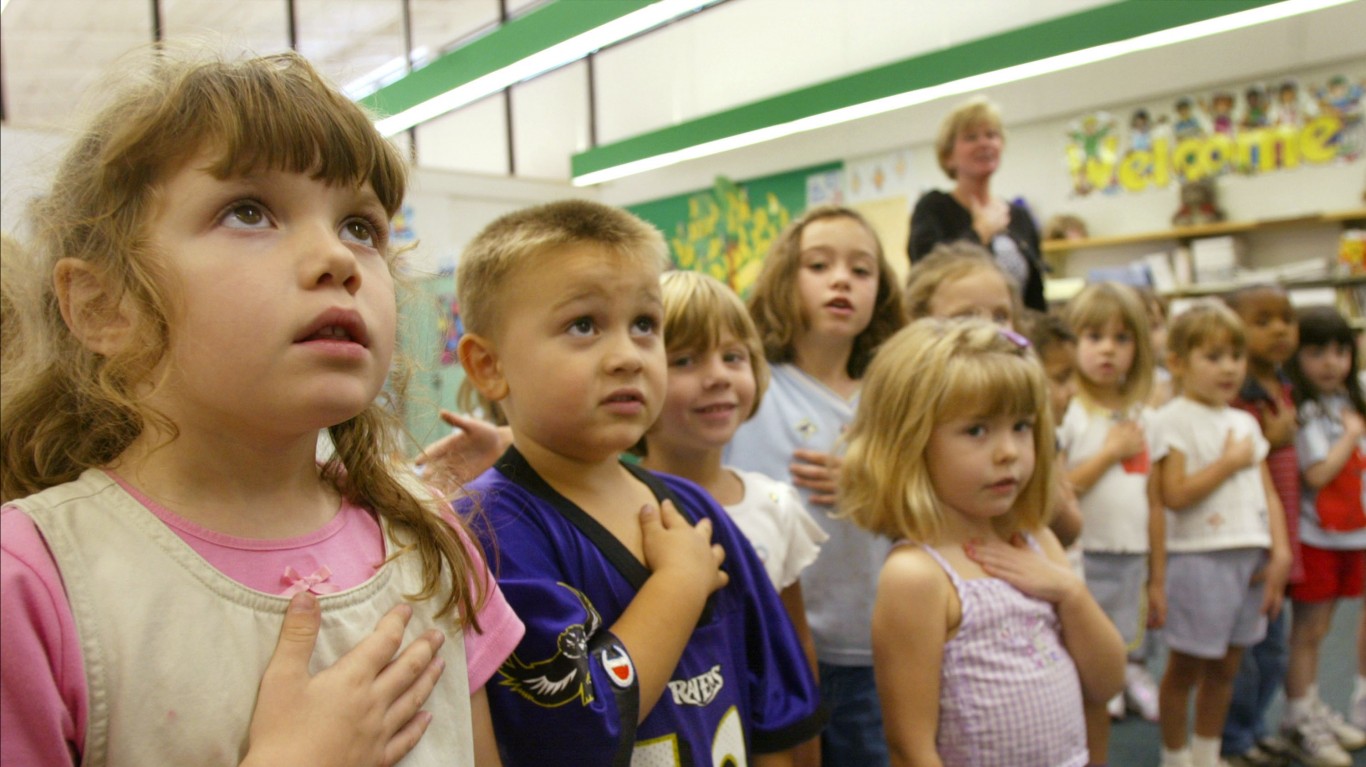
20. Alabama
> Share of 3-4 yr. olds enrolled in pre-K: 42.6% (19th lowest)
> Annual state pre-K spending: $122.8 million (16th highest)
> State pre-K spending per pre-K student: $8,926 (11th highest)
> 4th graders proficient in reading: 28.2% (4th lowest); math: 28.1% (the lowest)
Alabama’s pre-K system ranks better than most other states, partially due to high investment. Pre-K spending in Alabama totaled $8,926 per pupil in 2020, more than in all but 10 other states. Alabama’s state-run pre-K programs also meet each quality benchmark defined by NIEER, an accomplishment few other states can claim.
However, in some ways, Alabama lags behind many other states. For example, state pre-K is not available to 3-year-olds in the state, and partially as a result, the state;s pre-K enrollment of 42.6% is lower than in most other states.
[in-text-ad]

19. New York
> Share of 3-4 yr. olds enrolled in pre-K: 53.5% (8th highest)
> Annual state pre-K spending: $834.2 million (3rd highest)
> State pre-K spending per pre-K student: $7,036 (23rd highest)
> 4th graders proficient in reading: 34.3% (21st lowest); math: 36.9% (13th lowest)
New York is one of only a dozen states where more than half of all 3- and 4-year-olds are enrolled in pre-K. The majority of them — nearly 62% — attend a public preschool. New York’s Universal Prekindergarten Program began in 1998. The program makes public pre-K available to all 4-year-old children in the state, regardless of household income or other risk factors.
New York state spent $834.2 million on pre-K programs in 2020, more than all but two other states. On a per pupil basis, however, pre-K spending totaled $7,036 in 2020, close to the median across all states.
18. Maryland
> Share of 3-4 yr. olds enrolled in pre-K: 48.2% (18th highest)
> Annual state pre-K spending: $158.1 million (13th highest)
> State pre-K spending per pre-K student: $8,780 (12th highest)
> 4th graders proficient in reading: 35.1% (24th highest); math: 39.1% (19th lowest)
Early education in Maryland ranks as 18th best among the 50 states. The slightly better than average ranking is due in part to greater than average investment and enrollment. Pre-K spending in Maryland totaled $8,780 per student in 2020, more than in all but 11 other states. Additionally, a slightly larger than average 48.2% share of 3- and 4-year-olds in Maryland are enrolled in a pre-K program.
Maryland’s state-run preschool programs meet most quality benchmarks established by NIEER. However, the state’s ranking would improve with standards that keep 3- and 4-year-old class sizes below 20 children. Maryland Gov. Larry Hogan vetoed a bill passed in the 2020 legislative session that would have invested heavily in early childhood programs in the state.

17. Illinois
> Share of 3-4 yr. olds enrolled in pre-K: 53.7% (6th highest)
> Annual state pre-K spending: $428.3 million (5th highest)
> State pre-K spending per pre-K student: $5,885 (24th lowest)
> 4th graders proficient in reading: 34.4% (23rd lowest); math: 38.5% (16th lowest)
Illinois spent $428.3 million on pre-K programs in 2020, more than all but four other states. On a per pupil basis, however, pre-K spending totaled $5,885 in 2020, close to the median across all states. Illinois is also one of only a dozen states where more than half of all 3- and 4-year-olds are enrolled in pre-K.
In 2006, Illinois started its Preschool for All initiative with the goal of offering a public preschool option to all 3- and 4- year-olds in the state within six years. However, due to state budget constraints, enrollment is limited, and children who are considered to be at-risk are prioritized. Currently, just over half of 3- and 4- year-olds enrolled in pre-K in the state, and 59.3% of them are enrolled in a publicly funded program.
[in-text-ad-2]

16. Oklahoma
> Share of 3-4 yr. olds enrolled in pre-K: 43.0% (20th lowest)
> Annual state pre-K spending: $196.7 million (10th highest)
> State pre-K spending per pre-K student: $9,404 (8th highest)
> 4th graders proficient in reading: 28.5% (5th lowest); math: 34.5% (9th lowest)
Early childhood education in Oklahoma ranks higher than ECE in all but 15 other states. The state’s relatively favorable ranking is due to high-quality standards at public preschools. Pre-K programs in Oklahoma meet nine out of 10 quality benchmarks established by NIEER. Per student pre-K spending is also relatively high in Oklahoma, at $9,404 in 2020, eighth highest among states.
However, the state’s schools, including those involved in early childhood education, appear to be lagging behind much of the country in terms of teaching students core concepts. Only 28.5% of fourth graders in the state are proficient in reading, and 34.5% are proficient in math, each among the 10 lowest shares of any state.

15. Iowa
> Share of 3-4 yr. olds enrolled in pre-K: 45.7% (25th lowest)
> Annual state pre-K spending: $94.0 million (22nd highest)
> State pre-K spending per pre-K student: $3,692 (14th lowest)
> 4th graders proficient in reading: 35.1% (23rd highest); math: 42.0% (20th highest)
Iowa rounds out the list of the top 15 states for early childhood education partially because of strong investment. The Child Care and Development Fund is a federal and state partnership that provides low-income families with child care assistance and funds aimed at improving early childhood education standards. In Iowa, 19.3% of children living below the poverty line receive CCDF funds, the fourth largest share of any state and well above the 11.6% national share.
Additionally, state funded pre-K programs in Iowa meet the vast majority of quality benchmarks established by NIEER. An estimated 45.7% of 3- and 4-year-olds in Iowa are enrolled in a pre-K program, closely in line with the national average.
[in-text-ad]

14. Minnesota
> Share of 3-4 yr. olds enrolled in pre-K: 47.4% (21st highest)
> Annual state pre-K spending: $51.7 million (20th lowest)
> State pre-K spending per pre-K student: $7,177 (22nd highest)
> 4th graders proficient in reading: 38.1% (10th highest); math: 52.9% (the highest)
Despite middling enrollment and investment figures, Minnesota ranks higher for early childhood education than most states. An estimated 47.4% of 3- and 4-year-olds in the state are in a pre-K program, a larger share than in only a slight majority of states. Similarly, pre-K spending in Minnesota totaled $7,177 per student in 2020, close to the median among all states.
The state’s high ranking is due in large part to standardized test scores that reflect favorably on the quality of early childhood education. A reported 38.1% of fourth graders in the state are proficient in reading, and 52.9% are proficient in math, the 10th highest and highest shares among states, respectively.

13. North Carolina
> Share of 3-4 yr. olds enrolled in pre-K: 44.3% (21st lowest)
> Annual state pre-K spending: $166.3 million (12th highest)
> State pre-K spending per pre-K student: $10,122 (5th highest)
> 4th graders proficient in reading: 36.0% (19th highest); math: 41.4% (22nd highest)
Early childhood education investment in North Carolina eclipses that of many other states. Pre-K spending in the state totaled $10,122 per student in 2020, the fifth highest per student spending in the country. Due in part to the high investment, the state meets most quality benchmarks established by NIEER. Standards in North Carolina include limits on class sizes to 18 or less, a student-to-teacher ratio of no more than one-to-nine, and teachers must have a bachelor’s degree.
Public pre-K in North Carolina targets at-risk 4-year-olds in low-income households. Overall pre-K enrollment in the state is split nearly evenly between public and private institutions, with slightly more 3- and 4-year old children enrolled in public programs.

12. Mississippi
> Share of 3-4 yr. olds enrolled in pre-K: 53.7% (7th highest)
> Annual state pre-K spending: $6.7 million (9th lowest)
> State pre-K spending per pre-K student: $5,704 (22nd lowest)
> 4th graders proficient in reading: 31.5% (11th lowest); math: 38.8% (18th lowest)
Early childhood education in Mississippi ranks higher than every other state in the Deep South and 12th highest among all states. The state boasts one of the highest pre-K enrollment rates in the country, with 53.7% of 3- and 4-year-olds enrolled, a larger share than in all but half a dozen other states. Mississippi is also one of only five states where state-funded pre-K programs meet all 10 quality benchmarks established by NIEER.
Recently, Mississippi has greatly expanded its investment in early childhood education. Higher spending may lead to improved outcomes for students in the state in later years. Currently, standardized test scores among fourth graders in the state in reading and math lag behind much of the rest of the nation.
[in-text-ad-2]

11. Hawaii
> Share of 3-4 yr. olds enrolled in pre-K: 51.6% (10th highest)
> Annual state pre-K spending: $6.7 million (10th lowest)
> State pre-K spending per pre-K student: $9,886 (6th highest)
> 4th graders proficient in reading: 33.8% (18th lowest); math: 39.8% (23rd lowest)
Hawaii spends more on pre-K per student than most other states. Pre-K investment in the state totaled $9,886 per pupil in 2020, sixth highest among states. Preschool-aged children in Hawaii are also more likely to be in a pre-K program than most of those in the same age group nationwide as Hawaii is one of only 12 states where over half of all 3- and 4-year-olds are enrolled.
Hawaii’s relatively high ranking for early childhood education is also due to high standards in state-run programs. Hawaii is one of only five states where state-funded pre-K programs meet all 10 quality benchmarks established by NIEER.

10. Nebraska
> Share of 3-4 yr. olds enrolled in pre-K: 45.6% (24th lowest)
> Annual state pre-K spending: $28.0 million (19th lowest)
> State pre-K spending per pre-K student: $8,986 (10th highest)
> 4th graders proficient in reading: 36.8% (15th highest); math: 45.5% (11th highest)
Nebraska rounds out the list of the 10 best states for early childhood education. The state’s high ranking is partially attributable to early childhood education funding. Pre-K investment in Nebraska totaled $8,986 per pupil in 2020, 10th highest among states. The Child Care and Development Fund is a federal and state partnership that provides low-income families with child care assistance and funds aimed at improving early childhood education standards. In Nebraska, 18.2% of children living below the poverty line receive CCDF funds, the ninth highest share of any state and well above the 11.6% national share.
The state’s high ranking is also due in part to standardized test scores among older children that may reflect favorably on the quality of early childhood education. A reported 36.8% of fourth graders in the state are proficient in reading, and 45.5% are proficient in math, each higher than the comparable shares in most other states.
[in-text-ad]
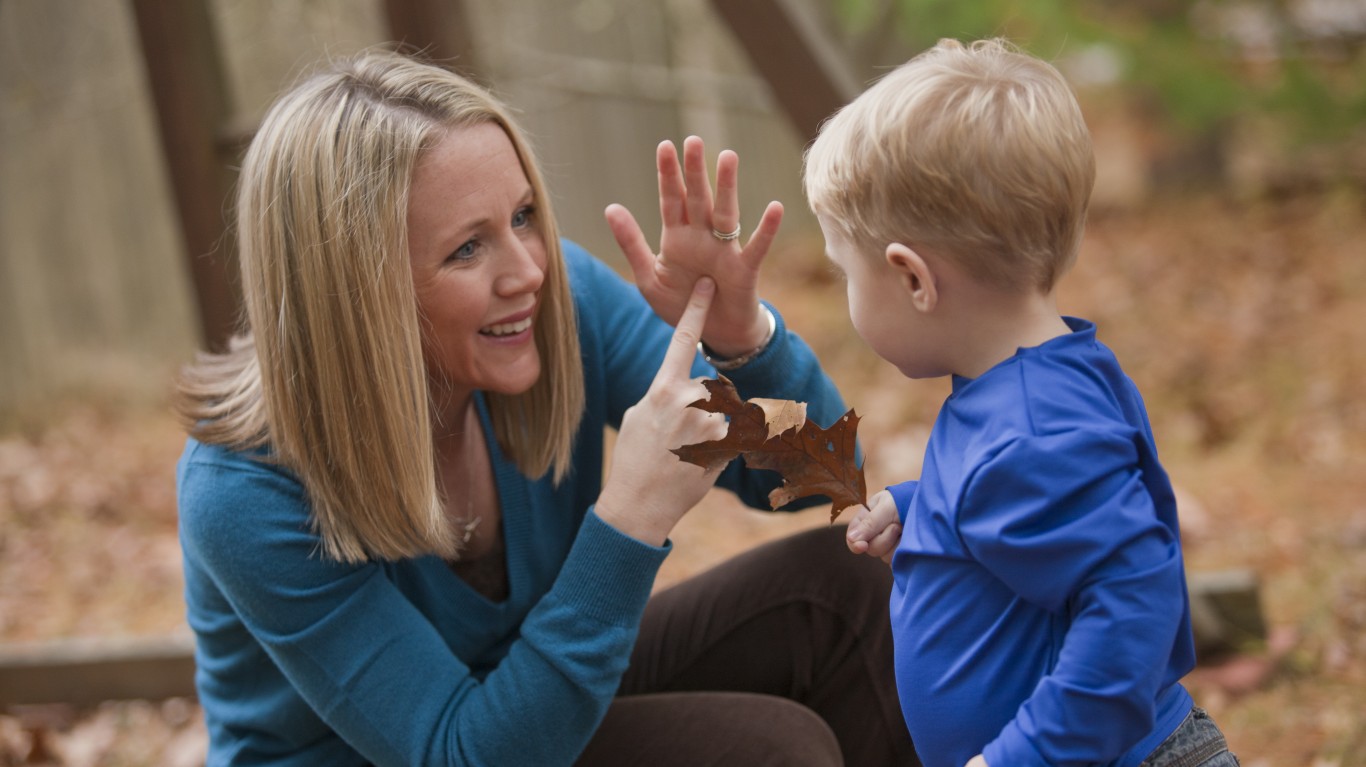
9. Massachusetts
> Share of 3-4 yr. olds enrolled in pre-K: 56.8% (5th highest)
> Annual state pre-K spending: $105.8 million (18th highest)
> State pre-K spending per pre-K student: $3,705 (16th lowest)
> 4th graders proficient in reading: 45.4% (the highest); math: 50.2% (2nd highest)
Massachusetts has some of the highest pre-K enrollment of any state. An estimated 56.8% of 3- and 4-year-old children in Massachusetts are enrolled in a pre-K program, the fifth largest share of any state. The strong enrollment is partially attributable to the state’s Universal Prekindergarten Program, which is available to children as young as 2 years and 9 months.
Early childhood education programs, like universal preschool, can improve academic outcomes in later years. In Massachusetts, 45.4% of fourth graders in the state are proficient in reading, and 50.2% are proficient in math, the highest and second highest shares among states, respectively.
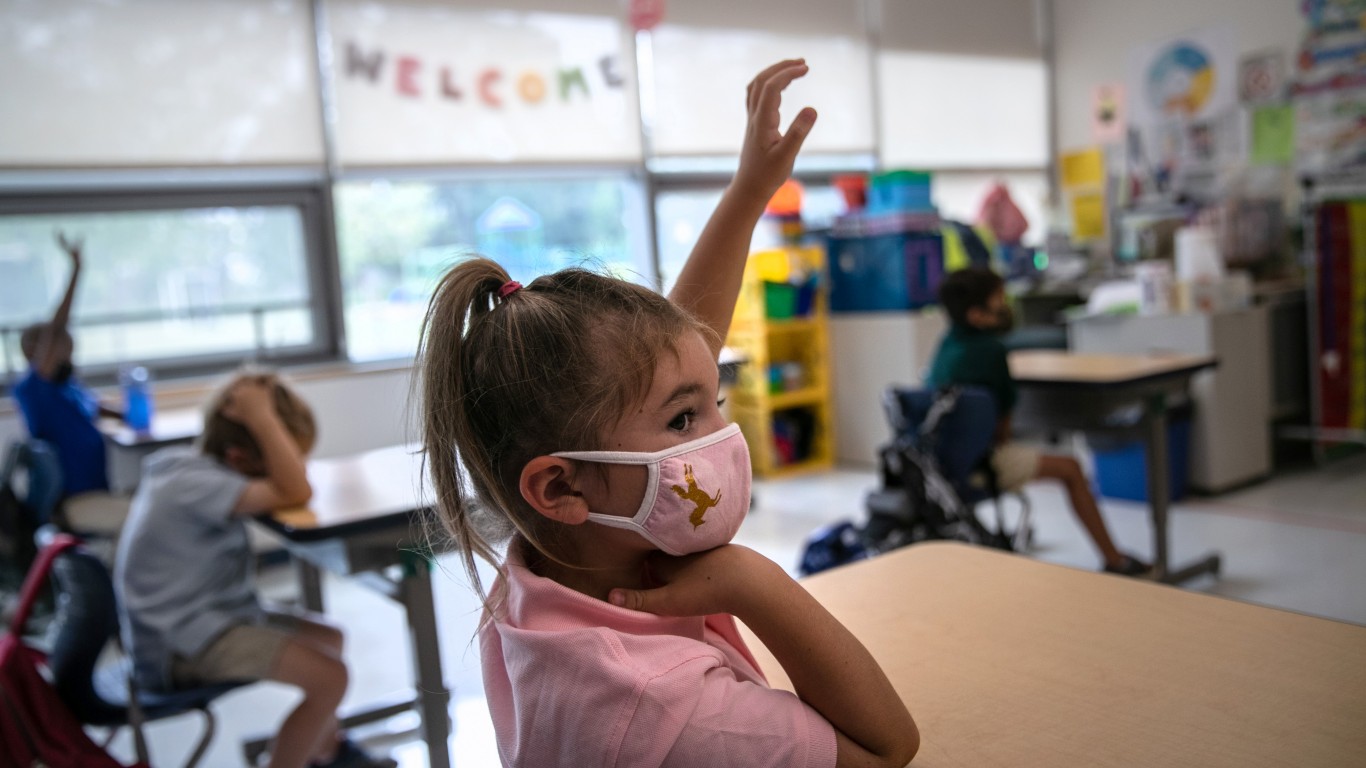
8. Maine
> Share of 3-4 yr. olds enrolled in pre-K: 48.5% (16th highest)
> Annual state pre-K spending: $23.9 million (17th lowest)
> State pre-K spending per pre-K student: $8,392 (15th highest)
> 4th graders proficient in reading: 36.0% (18th highest); math: 41.8% (21st highest)
Over half of the 10 states that rank highest for early childhood education are in the Northeast, and Maine is one of them. State-run pre-K programs in Maine meet nearly every quality standard established by NIEER. The state’s higher-quality standards are due in part to greater investment. Per pupil pre-K spending in Maine totaled $8,392, higher than in the majority of states.
Maine’s high ranking is also due in part to standardized test scores of fourth graders that may reflect favorably on the quality of early childhood education. A reported 36.0% of fourth graders in the state are proficient in reading, and 41.8% are proficient in math, each higher than the comparable shares in most other states.

7. Washington
> Share of 3-4 yr. olds enrolled in pre-K: 48.8% (14th highest)
> Annual state pre-K spending: $132.2 million (14th highest)
> State pre-K spending per pre-K student: $9,443 (7th highest)
> 4th graders proficient in reading: 35.1% (25th highest); math: 39.3% (21st lowest)
Washington state ranks highest for early childhood education of any state in the West and seventh highest overall. State-run pre-K programs in Washington meet nearly every quality standard established by NIEER. The state’s higher-quality standards are due in part to greater investment. Per pupil pre-K spending in Washington totaled $9,443, higher than in all but half a dozen states.
Washington’s standards are in place to ensure that at least 90% of children are ready for kindergarten. The state has additional programs that go beyond the scope of traditional pre-K for especially at-risk children, providing them with nutrition, health, and family support services, in addition to education.
[in-text-ad-2]

6. Pennsylvania
> Share of 3-4 yr. olds enrolled in pre-K: 42.2% (16th lowest)
> Annual state pre-K spending: $333.9 million (8th highest)
> State pre-K spending per pre-K student: $6,849 (24th highest)
> 4th graders proficient in reading: 39.7% (6th highest); math: 47.3% (7th highest)
Pennsylvania ranks as the sixth best state for early childhood education. The state’s high ranking is partially attributable to early childhood education funding. The Child Care and Development Fund is a federal and state partnership that provides low-income families with child care assistance and funds aimed at improving early childhood education standards. In Pennsylvania, 22.8% of children living below the poverty line receive CCDF funds, the third highest share of any state and well above the 11.6% national share.
Pennsylvania’s high ranking is also due in part to standardized test scores at a later stage that may reflect favorably on the quality of early childhood education. A reported 39.7% of fourth graders in the state are proficient in reading, and 47.3% are proficient in math, the sixth and seventh highest share among states, respectively.

5. Connecticut
> Share of 3-4 yr. olds enrolled in pre-K: 60.7% (3rd highest)
> Annual state pre-K spending: $126.0 million (15th highest)
> State pre-K spending per pre-K student: $8,478 (13th highest)
> 4th graders proficient in reading: 40.1% (4th highest); math: 45.0% (12th highest)
Connecticut ranks among the top five states for early childhood education, partially because of high preschool enrollment. The state is one of only three in the country where more than 60% of 3- and 4-year-old children are in a pre-K program.
The state’s high enrollment figures are partially explained by the three state-funded pre-K programs: School Readiness Program, Child Day Care Contracts, and Smart Start — each of which falls under the purview of the Connecticut Office of Early Childhood. These programs are also well established. With the exception of Smart Start, which was founded in 2014, Connecticut’s early childhood programs are decades old. Children in Connecticut are far more likely to attend a publicly funded pre-K program than a private program.
[in-text-ad]

4. Delaware
> Share of 3-4 yr. olds enrolled in pre-K: 53.0% (9th highest)
> Annual state pre-K spending: $6.1 million (8th lowest)
> State pre-K spending per pre-K student: $7,277 (20th highest)
> 4th graders proficient in reading: 32.5% (16th lowest); math: 39.1% (20th lowest)
Delaware is one of a dozen states where over half of all 3- and 4-year-olds are enrolled in a pre-K program. The high enrollment is partially attributable to a robust state-run pre-k program. Delaware began providing early childhood education to 4-year-olds eligible for the federal Head Start program in 1994 through the Delaware Early Childhood Assistance Program. The program expanded eligibility to 3-year-olds in 2017.
State-run ECE programs in Delaware have higher operating standards than in most states, as they meet nearly every quality standard established by NIEER.
3. Rhode Island
> Share of 3-4 yr. olds enrolled in pre-K: 47.9% (20th highest)
> Annual state pre-K spending: $13.8 million (13th lowest)
> State pre-K spending per pre-K student: $10,650 (2nd highest)
> 4th graders proficient in reading: 35.4% (22nd highest); math: 40.5% (24th highest)
Rhode Island ranks as the third best state for early childhood education. The state’s high ranking is partially attributable to early childhood education funding. Pre-K spending in Rhode Island totaled $10,650 per student in 2020, more than every state other than New Jersey.
Rhode Island’s state-funded pre-K program has been in operation for over a decade, and enrollment is determined by lottery. The program meets nearly every quality benchmark established by NIEER.

2. Vermont
> Share of 3-4 yr. olds enrolled in pre-K: 68.3% (the highest)
> Annual state pre-K spending: $60.1 million (21st lowest)
> State pre-K spending per pre-K student: $7,821 (18th highest)
> 4th graders proficient in reading: 37.1% (13th highest); math: 38.8% (17th lowest)
Early childhood education in Vermont ranks second highest in the United States, trailing only New Jersey. An estimated 68.3% of 3- and 4-year-olds in Vermont are enrolled in a pre-K program, the largest share of any state. While the state has had some early childhood education programs for decades, it was not until 2014 that all public school districts in Vermont were required to offer universal pre-K for all 3-, 4-, and 5-year-olds not enrolled in kindergarten for at least 10 hours per week, 35 weeks per year.
Vermont also has a robust pre-K quality monitoring system and meets most quality benchmarks established by NIEER.
[in-text-ad-2]

1. New Jersey
> Share of 3-4 yr. olds enrolled in pre-K: 64.0% (2nd highest)
> Annual state pre-K spending: $781.5 million (4th highest)
> State pre-K spending per pre-K student: $14,103 (the highest)
> 4th graders proficient in reading: 41.9% (2nd highest); math: 48.2% (3rd highest)
No state invests more in early childhood education per student than New Jersey. Pre-K spending in the state totaled $14,103 per pupil in 2020, more than double the nationwide average. Children in New Jersey are also more likely than most American children to be enrolled in preschool. An estimated 64.0% of 3- and 4-year-olds in New Jersey are in a pre-K program, the second largest share of any state.
New Jersey’s top ranking is also due in part to standardized test scores of older children that may reflect favorably on the quality of early childhood education. A reported 41.9% of fourth graders in the state are proficient in reading, and 48.2% are proficient in math, the second and third highest share among states, respectively.
Methodology
To determine the states with the best and worst early education, 24/7 Wall St. developed an index of six different measures of preschool educational quality, including funding, the percentage of children in school, academic achievement, and education quality. Data on state, local, and federal spending on preschool per child by state in the 2019-20 school year came from the National Institute for Early Education Research’s State of Preschool 2020 Yearbook and was included in the index at full weight. Data on the percentage of 3- and 4-year-old children enrolled in preschool came from the U.S. Census Bureau’s 2019 American Community Survey and was included in the index at full weight. Data on both the percentage of fourth grade students who are at or above the National Assessment of Educational Progress’ proficiency level in math and in reading in 2019 came from The Nation’s Report Card and were each included in the index at half weight. Data on the ratio of children receiving Child Care and Development Fund payments for every 100 children 18 and under living in poverty in 2019 was calculated using data from the Office of the Comptroller of the Currency and the 2019 ACS and was included in the index at full weight. Finally, the number of NIEER quality standard benchmarks that each state’s preschool program met (out of 10) as of 2020 came from the NIEER’s State of Preschool 2020 Yearbook and was included in the index at full weight.
Are you ahead, or behind on retirement? For families with more than $500,000 saved for retirement, finding a financial advisor who puts your interest first can be the difference, and today it’s easier than ever. SmartAsset’s free tool matches you with up to three fiduciary financial advisors who serve your area in minutes. Each advisor has been carefully vetted and must act in your best interests. Start your search now.
If you’ve saved and built a substantial nest egg for you and your family, don’t delay; get started right here and help your retirement dreams become a retirement reality.
Thank you for reading! Have some feedback for us?
Contact the 24/7 Wall St. editorial team.